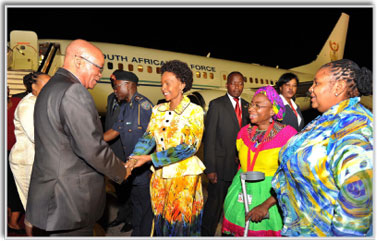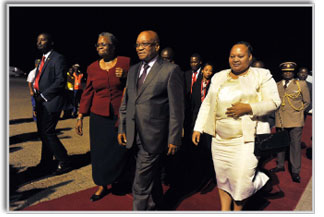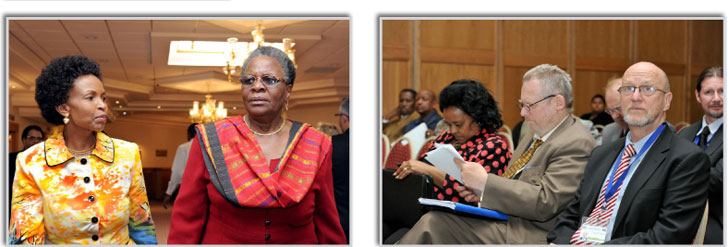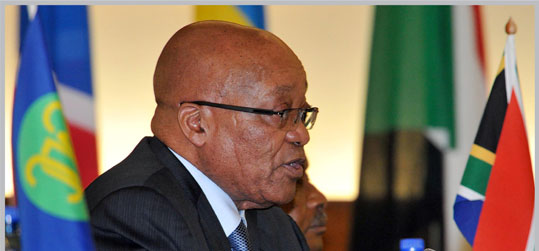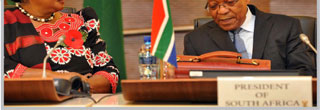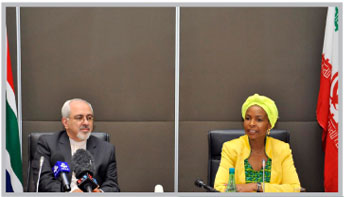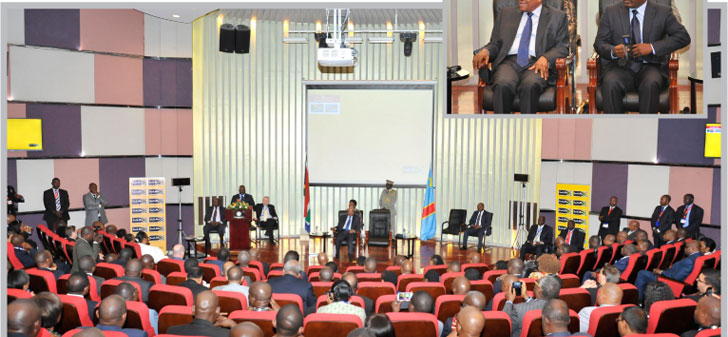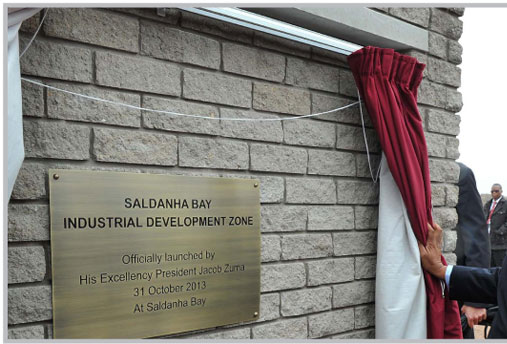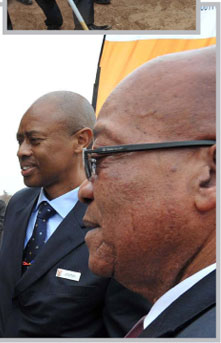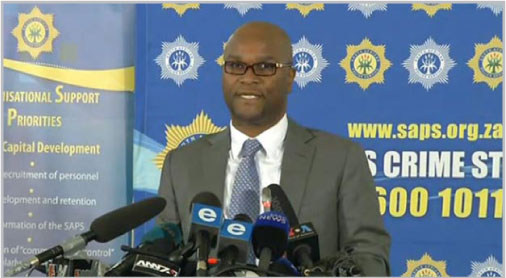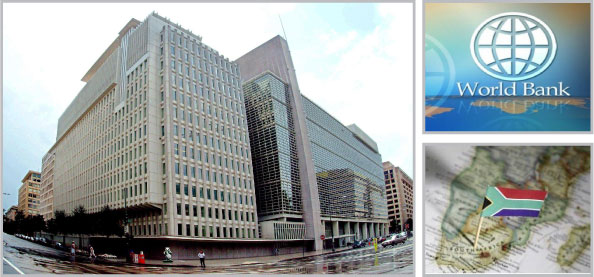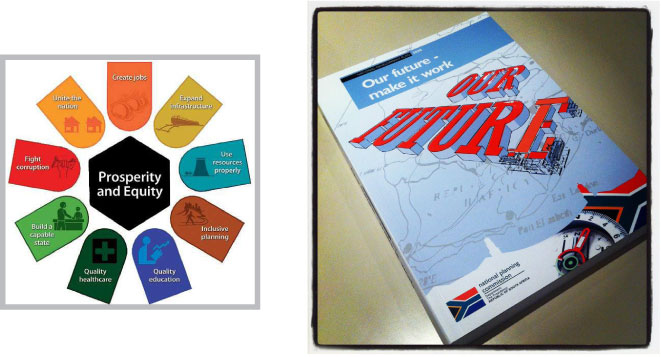| |
|
| |
|
|
| |
At the invitation of President Hifikepunye Pohamba of the Republic of Namibia, President Jacob Zuma led a high-level government delegation on a State Visit to Namibia from 6 to 7 November 2013.
South Africa is the destination of 66% of Namibia’s exports and holds approximately 80% of investments in key sectors of Namibia’s economy such as mining, retail, banking and insurance.
Namibia is one of the eight leading tourist markets for South Africa in the Southern African Development Community (SADC) region, with more than 200 000 tourists visiting each year.
The highest proportion of SADC tourists to South Africa on business in 2012 came from Namibia (25,9%). |
|
| |
|
| |
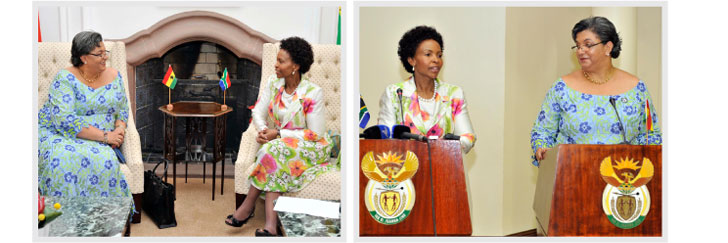 |
|
| |
 |
 |
|
MINISTER NKOANA-MASHABANE CO-CHAIRS SOUTH AFRICA-GHANA PERMANENT JOINT COMMISSION FOR COOPERATION (PJCC) |
|
|
| |
|
The Ministerial PJCC was aimed at strengthening bilateral relations and further exploring cooperation in the fields of mining, retail, insurance, transport, tourism, banking, telecommunications, construction, services, franchising, manufacturing, fishing, advertising, aviation and energy. The ministers also used the PJCC to discuss regional, continental and multilateral issues of mutual interest. |
|
|
 |
 |
|
|
| |
| |
The Minister of International Relations and Cooperation, Maite Nkoana-Mashabane, hosted her counterpart from the Republic of Ghana, Hannah Tetteh, Minister of Foreign Affairs and Regional Integration, for the Third Session of the PJCC on 5 November 2013 in Pretoria, ahead of the outgoing State Visit by President Jacob Zuma to Ghana scheduled for 26 to 27 November 2013.
Bilateral political relations between South Africa and Ghana, one of the most stable multiparty democracies in the West African region, are very good, with both countries maintaining residential diplomatic missions in each other’s capitals.
Ghana represents a major export market for South African goods, although the total trade volumes are still relatively low in global terms. In 2012, South African exports to Ghana were estimated at R4,456 billion and imports from Ghana at R1,9 billion. The bilateral trade between South Africa and Ghana experienced an upward trend between 2008 and 2012, growing from R3,1 billion to R6 billion respectively. |
| |
| |
 |
|
| |
|
| |
|
South Africa hosted the Joint Southern African Development Community (SADC)-International Conference on the Great Lakes Region (ICGLR) Summit on 3 and 4 November 2013 at the OR Tambo Building in Pretoria.
The summit considered a report of the Joint Ministerial Meeting on the Implementation of the Peace, Security and Cooperation Framework for the Democratic Republic of Congo and the region.
The Department of International Relations and Cooperation (DIRCO) said South Africa continued to play a significant role in peace and security activities at regional and continental levels in operations, both strategically and financially.
“This is based on the belief that regional peace, security and stability are key determinants for socio-economic development and a critical factor for regional integration.
"Regional integration is critical if we are to expand intra-Africa trade,” DIRCO said.
South Africa also hosted a Consultative Summit on the African Capacity for Immediate Response to Crises (ACIRC) on 5 November 2013 at the OR Tambo Building.
The purpose of the summit was to consult with volunteering countries that have expressed willingness to contribute to ACIRC. The meeting considered the modalities for the operationalisation of ACIRC.
During the May 2013 African Union Summit, the Assembly of Heads of State and Government decided to establish ACIRC as a transitional arrangement pending the full operationalisation of the African Standby Force (ASF) and its Rapid Deployment Capability. This is within the framework of the agreed-upon African Peace and Security Architecture.
The summit was the first round of informal consultations between like-minded and willing contributing countries on the issue of rapid response to crises within the context of the proposed ASF. It is an interim measure to deal with conflict on the continent in the context of African solutions for African problems.
The expected outcome of the consultations is an agreed-upon framework for modalities and to identify a road map for a way forward. – www.SAnews.gov.za |
|
| |
|
| |
DEPUTY MINISTER EBRAHIM CONCLUDES VISIT TO AUSTRALIA |
| |
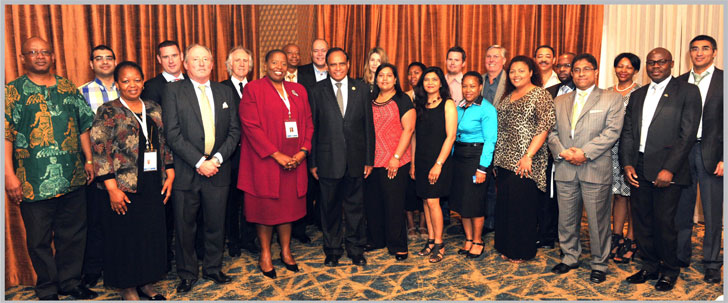 |
| |
Deputy Minister Ebrahim announced South Africa’s willingness to assume the position of Vice Chair of IORA in 2015, leading to its chairing from 2017 to 2019. |
| |
The Deputy Minister of International Relations and Cooperation, Ebrahim Ebrahim, has concluded a visit to Australia, where he attended the 13th Meeting of the Council of Ministers of the Indian Ocean Rim Association (IORA), held on 1 November 2013 in Perth.
Deputy Minister Ebrahim attended the meeting within the context of strengthening cooperation with the member states of the IORA in the interest of increasing South Africa’s trade relations with those countries.
As a founding member, South Africa welcomed these important developments as a step that signified the renewed determination to strengthen the association. An important milestone of the 13th meeting was the adoption of IORA as the new name for the organisation, known formerly as the Indian Ocean Rim Association for Regional Cooperation (IOR-ARC).
As the leading body for the promotion of regional collaboration across the Indian Ocean rim, IORA will take forward its role in addressing the development, security, resource and environmental challenges. Therefore, IORA will broaden and deepen efforts to bolster maritime security and safety, particularly continued threats to maritime commerce, and freedom of the high seas inconsistent with the United Nations Convention on the Law of the Seas (UNCLOS). In this regard, South Africa will closely work with other IORA members to fight challenges posed by fisheries and piracy.
The Indian Ocean is the third-largest of the world’s oceanic divisions, covering approximately 20% of the water on the Earth’s surface, boasting a coastline of 66 526 km.
According to the Asia-Pacific Centre for Security Studies (2003), the IOR area has 40% of the world’s oil and gas reserves.
An estimated 80% of the world’s seaborne oil trade transits through the Indian Ocean, largely from the west (the Persian Gulf) to the east (China, India, and Japan). The significance of this trade route presents several opportunities for a littoral state such as South Africa, particularly from a trade facilitation vantage point. South Africa also sees the opportunity to strengthen Africa-Asia ties through cooperation within the IORA.
In addition, it is important for South Africa to take advantage of the opportunities by increasing its market products to the Indian Ocean region. Accordingly, South Africa’s approach to this setting is in line with that of South-South cooperation, which is a foreign policy priority. |
| |
 |
|
| |
|
| |
| DEPUTY MINISTER EBRAHIM UNDERTAKES OFFICIAL VISIT TO NORTH KOREA |
| |
| The two countries enjoy a cordial relation that dates back due to the historic support which the DPRK provided during the struggle against colonialism and apartheid. |
| |
The Deputy Minister of International Relations and Cooperation, Ebrahim Ebrahim, undertook an Official Visit to the Democratic People’s Republic of Korea (DPRK) from 5 to 7 November 2013.
Deputy Minister Ebrahim’s visit to the DPRK was aimed at strengthening bilateral relations that exist between the two countries. Diplomatic relations between the two countries were established in August 1998.
This was a long-standing visit since a visit by former Deputy Minister, Aziz Pahad, who visited Pyongyang in 2005.
Economic relations between the two countries remain limited due to the United Nations Security Council (UNSC) imposed sanctions on the DPRK as a result of its nuclear programme, which plays out on the ongoing Korean Peninsula tension.
In this regard, South Africa holds very strong views on nuclear disarmament and non-proliferation, which it conveys to the DPRK on all occasions by indicating that the strength of a country is in its economy, not in its military as one can win war but lose peace.
South Africa has been urging North Korea not to go ahead with building a nuclear programme. Equally so, South Africa respects the rights of all Non-Proliferation Treaty (NPT) member states to legitimately develop nuclear energy for peaceful civilian purposes. However, South Africa believes that a nuclear arsenal does not confer greater security for any state.
During the visit, Deputy Minister Ebrahim further encouraged North Korea to open up to South Korea and also goes back to the Six-Party Talks, aimed at ending North Korea’s Nuclear Programme through negotiations. |
|
| |
|
| |
DIRCO HOSTS BRICS NATIONAL YOUTH CONSULTATIVE FORUM |
| |
The meeting developed a South African youth development policy position on BRICS for consideration by the envisaged BRICS Youth Policy Dialogue to be hosted by South Africa in February 2014. |
| |
|
|
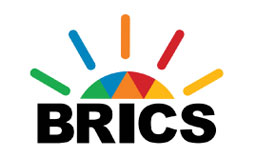 |
| |
|
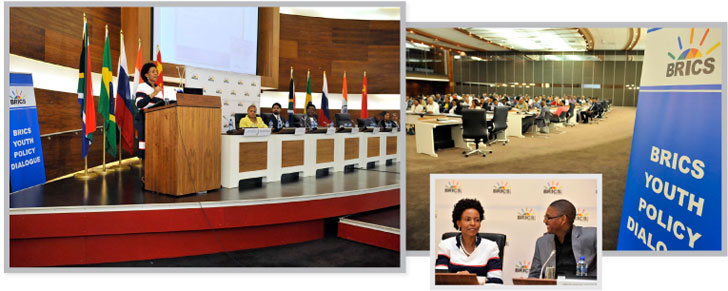 |
|
| |
The Department of International Relations and Cooperation, in partnership with The Presidency and the National Youth Development Agency, hosted the Brazil, Russian, India China, South Africa (BRICS) National Youth Consultative Forum on 1 November 2013.
Under the theme “The Role of BRICS in Youth Development”, the youth exchanged their views on the implementation of a proposed BRICS programme of action for youth.
On 30 October, a joint declaration issued by the Third BRICS Ministers of Agriculture and Agrarian Development said that BRICS was crucial to dealing with the global food crisis. The ministers met in Pretoria to adopt tangible measures to boost domestic agricultural productivity.
The ministers also welcomed discussions aimed at establishing the Basic Agricultural Information Exchange System of the BRICS countries.
However, they noted that such a system should not be a duplication of the Agriculture Marketing Information System, created under the G20 and administered by the Food and Agriculture Organisation of the United Nations.
The gathering also reaffirmed its support for such a system as a platform for sharing information, and called upon technical experts in their countries to continue working together for the development of the system. |
|
| |
|
| |
MINISTER NKOANA-MASHABANE HOSTS HER IRANIAN COUNTERPART |
| |
South Africa and Iran share compatible economies that can benefit from greater trade, skills transfer, technology research and development. |
| |
|
|
| |
|
| |
|
| |
The presidents reaffirmed their commitment to work together to address the underlying security challenges facing the Democratic Republic of Congo (DRC). |
| |
President Jacob Zuma and his DRC counterpart, Joseph Kabila Kabange, have committed to prioritise key areas of cooperation, including trade and investment, energy and infrastructure, among others.
President Zuma returned from a successful two-day state visit to the DRC on 30 October, where he held bilateral discussions with President Kabila.
This was President Zuma’s first State Visit to the DRC, which saw the signing of the all-important Grand Inga Treaty. The treaty outlines the development of the Grand Inga complex, currently estimated at US$100 billion.
President Zuma’s visit also took place at a time when the DRC is experiencing relative stability as a result of the role of the Intervention Brigade, which South Africa is part of. South Africa has played a crucial role in the realisation of peace and stability in the DRC since 1997.
The Minister of International Relations and Cooperation, Maite Nkoana-Mashabane, joined other senior officials at the First Session of the Ministerial Meeting of the Angola-DRC-South Africa Tripartite Mechanism on Dialogue and Cooperation ahead of President Zuma’s visit.
The Minister said she was pleased with the outcome of the meeting, given that critical decisions were made with regard to the implementation of the tripartite mechanism.
“We have rededicated ourselves to make this unique mechanism a success consistent with the directives of our heads of state. We have agreed to work towards the operationalisation of the Permanent Secretariat and we have committed ourselves to speed up the ratification process of the MoU on the tripartite mechanism,” said the Minister.
On 12 March 2013, Angola, South Africa and the DRC set up the tripartite cooperation mechanism.
It is a body designed to help consolidate peace in the Great Lakes Region, and safeguard the conditions favourable to the implementation of the Framework Accord for Peace, Stability and Cooperation in the DRC, signed on 24 February 2013 in Addis Ababa, Ethiopia. – www.SAnews.gov.za |
|
| |
|
| |
|
| |
President Jacob Zuma officially launched the Saldanha Bay IDZ at Saldanha Bay on South Africa’s south-western coast on 31 October 2013.
The new IDZ is expected to give a major boost to the country’s industrialisation and job creation drives, while attracting both local and FDI into the country.
“Our objective is to develop the Saldanha-Northern Cape linked region in an integrated manner through rail and port expansion as well as back-of-port industrial capacity,” President Zuma said.
“Our strategy is also aimed at strengthening the maritime support capacity to create economic opportunities from the gas and oil mining activities along the African west coast, as well as the expansion of iron ore mining production and beneficiation in the Northern Cape.” – SAinfo reporter and www.SAnews.gov.za |
|
| |
|
| |
CRIME IN SA AT 15-YEAR LOW: INDEX |
| |
South Africa has adopted a multipronged approach in the fight against crime, involving partnerships with communities, business, civic organisations and labour movements. |
| |
|
| |
Crime in South Africa is at its lowest level in 15 years, having dropped by 38% since its peak in the 2002/03 financial year, according to the latest crime index from global analytics company IHS.
“The decline in overall crime in South Africa has been echoed in both indices, reporting a steady decline since 2002,” IHS said in its report, released on 29 October 2013.
The report is divided into a violent crime index and a property crime index.
The Minister of Police, Nathi Mthethwa, said the findings vindicated the Government’s national crime statistics, which were released in September. While many local analysts were sceptical in their analysis of the statistics, it was gratifying that an internationally recognised, credible and globally respected institution had now affirmed the fact that crime was decreasing in South Africa, the Minister said.
“Since 1994, we have been making steady progress in the fight against crime. This period has been characterised by growing unity in action against crime, a period focussed on improving life conditions for all.” – www.SAnews.gov.za |
|
| |
|
| |
SA HOLDS STEADY FOR EASE OF BUSINESS |
| |
The World Bank’s 2014 report, titled "Doing Business: Understanding Regulations for Small and Medium-Size Enterprises", sheds light on how easy (or difficult) it is for a local entrepreneur to open and run a small to medium-sized business when complying with the relevant regulations. |
| |
|
| |
The country was ranked 41st out of 189 economies around the world surveyed by the World Bank, which judges countries on 10 criteria that measure the time, cost and hassle involved in doing business.
South Africa received points for its tax reforms, with its rating for paying taxes moving up two points to 24. The Government made paying taxes easier for companies by replacing the secondary tax on companies with a dividend borne by shareholders.
South Africa’s “distance to frontier” score also inched up in the rankings, to 70.93%. This measure represents the distance of each economy from the best performance observed on each of the topics.
The country remains a strong performer when it comes to protecting investors (10), especially in the category “allowing access to all corporate documents before a trial”.
Getting credit is becoming slightly more difficult in South Africa, however, with the country’s ranking dropping four places to 28th. South Africa is ranked at an impressive 39 for dealing with construction permits, and starting a business is also easier (53). The report notes that the country has lowered its registration fees and has substantially reduced its notary fees.
Together with its sub-Saharan partners, South Africa made progress in trading across borders, with its ranking improving four places to 106.
Getting electricity in the country remains weak, however, at 150. While relatively simple procedurally, it takes too long at an average of 226 days, and is too expensive, the report finds. – SAinfo reporter |
|
| |
|
| |
SUB-SAHARAN AFRICA TO GAIN 6,2% GROWTH IN 2014: IMF |
| |
The International Monetary Fund (IMF) said the latest outlook was not as strong as portrayed in the May 2013 edition, characterised by rising financing costs, less dynamic emerging market economies and less favourable commodity prices, as well as diverse domestic factors. |
| |
|
| |
Economic activity in sub-Saharan Africa was predicted to remain robust at a 5% growth in 2013 and 6,2% in 2014, said the IMF’s latest Regional Economic Report Outlook, published on 31 October 2013.
“Growth is expected to be particularly strong in mineral-exporting and low-income countries, including Côte d’Ivoire, the Democratic Republic of Congo, Mozambique, Rwanda, Sierra Leone and a few others,” said Antoinette Monsio Sayeh, Director of the IMF’s Africa Department.
The main factor behind the continuing growth in most of the region was, as in previous years, strong domestic demand, especially associated with investment in infrastructure and export capacity in many countries, the report added.
On inflation, the report said the region was expected to remain moderate in 2013 and 2014, reflecting continuing disinflation in low-income countries and benign prospects for food prices.
According to the report, headline inflation in sub-Saharan Africa has been on a declining trend since early 2012, facilitated by a slowdown and occasional reversal in food prices and the maintenance of tight monetary policies.
The report said fiscal deficits were also expected to expand in 2013 and 2014 in many countries in the region, adding that debt indicators remain benign in most countries. – www.SAnews.gov.za-Xinhua |
|
| |
|
| |
FORUM TO TACKLE SA COMPETITIVENESS |
| |
The forum brought together a cross-section of stakeholders to deliberate on what competitiveness is and why South Africa needs to be competitive. |
| |
|
| |
Over 200 high-level representatives of government, business, labour, civil society and academia gathered in Midrand on 5 November for the inaugural Competitiveness Forum hosted by Brand South Africa.
A critical part of the discussion was how the nation’s competitiveness could contribute to the implementation of the National Development Plan (NDP).
A policy blueprint for eliminating poverty and reducing inequality in South Africa by 2030, the NDP – also referred to as Vision 2030 – identifies the key constraints to faster growth and presents a road map to a more inclusive economy that will address the country’s socio-economic imbalances. – SAinfo reporter and Brand South Africa |
|
| |
|
| |
GHANAIAN TEAM BEGINS SKA TRAINING |
| |
The aim of the programme is to create a network of radio telescopes among Square Kilometre Array (SKA) South Africa’s African partner countries: Botswana, Ghana, Kenya, Madagascar, Mauritius, Mozambique, Namibia and Zambia. |
| |
Seven Ghanaians arrived in South Africa recently to begin training on the independent operation and maintenance of radio telescopes in Africa. Using a miniature version of a radio telecsope, they will learn how to design, build, operate and maintain an African telescope network that will support the scientific and technical activities of the SKA.
According to Joyce Koranteng-Acquah, a research scientist at the Ghana Atomic Energy Commission, the SKA is set to improve the lives of the average Ghanaian through the provision of jobs, infrastructure and tourism.
“The training programme marks the start of a programme to strengthen African technical capability,” the Deputy Minister of Science and Technology, Michael Masutha, said. “Involving the African partner countries in the AVN training programme is a means of ensuring that Africa is capacitated and ready for hosting the SKA.”
The Ghanaians began training on 14 October, and in their first two months will focus on the basics of radio telescope systems at the Hartebeesthoek Radio Astronomy Observatory, north of Johannesburg, and the SKA office in Cape Town. After this, another four months will be dedicated to developing their own telescope systems.
Using a miniature version of a radio telecsope, they will learn how to design, build, operate and maintain an African telescope network that will support the scientific and technical activities of the SKA.
|
|
|
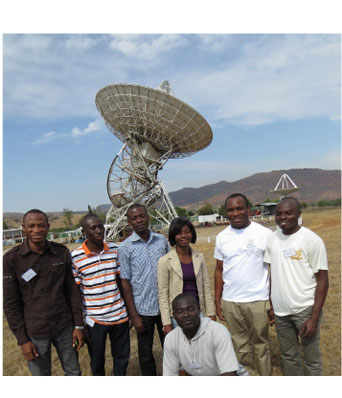 |
|
Further steps on the way to human capital development for the AVN include formal and informal training events, such as the so-called Joint Exchange Development Initiative (JEDI) workshops. In these relaxed but high-intensity environments, university students and staff are encouraged to problem-solve together by sharing knowledge and ideas.
A group of 14 astrophysics graduates from the University of Nairobi, Kenya, along with senior university staff, will be doing a five-day JEDI under the leadership of the SKA South Africa and AVN team. It is expected that JEDIs will be extensively conducted across the continent during 2014.
These and other training-focussed operations form part of what can be termed a holistic approach to human capital development for African radio astronomy. |
|
| |
|
| |
SOUTH AFRICA CELEBRATES DISABILITY RIGHTS AWARENESS MONTH |
| |
During the Disability Rights Awareness Month, government and its partners call on all South Africans to be informed, reflect on their own attitudes and how these attitudes are barriers to the equalisation of opportunities for persons with disabilities. |
| |
|
| |
South Africa celebrates National Disability Rights Awareness Month annually between 3 November and 3 December. 3 December marks the International Day of Persons with Disabilities and is also celebrated as National Disability Rights Awareness Day.
The South African Government, led by the Department of Women, Children and People with Disability as well as partners from all sectors of society are coordinating and implementing a comprehensive campaign to raise awareness on key issues affecting disabled people. |
|
| |
|
| |
US MAG TIPS DURBAN AS SA’S SECRET JEWEL |
| |
The weekly general interest magazine praises Durban’s “spectacular beaches” with their temperate Indian Ocean waters; the world-renowned aquarium at uShaka Marine World, “which is actually much larger than its Cape Town counterpart”; and the I Heart Market, which is held in the world-class Moses Mabhida Stadium for its “hand-stitched leather iPad cases, tribal-print baseball caps, and mod vintage dresses by local artisans and collectors”. |
| |
“Durban instead of Cape Town”, New York Magazine advises its readers in its winter travel 2013 special.
While the publication acknowledges that the world’s greatest cities “got their reputation for a reason”, they’ve decided to turn their attention to long-overshadowed cities such as Bourdeaux (not Paris), Birmingham (not London), Leipzig (not Berlin) – and Durban (not Cape Town).
“They may not sell as many guidebooks as their A-list counterparts, but they have just as much charm and excitement – with way, way fewer tourists.”
The city’s “vibrant blend” of Zulu, Indian and British influences means that the cuisine is more eclectic than Cape Town’s. Durban is well known locally for its curry – and the magazine urges visitors to try bunny chow, which is “messy curry served in a hollowed-out loaf of bread”.
Other top spots highlighted by the magazine are the chic Oyster Box Hotel; Ile Maurice, where the crêpes Suzettes are apparently unmissable; and Teremok Marine hotel in Umhlanga, which overlooks the harbour.
Cape Town was recently named in the top three best destinations in the world to visit by Lonely Planet, the global travel publishers. |
| |
|
|
| |
|
|
|
|
|
|
|
|




